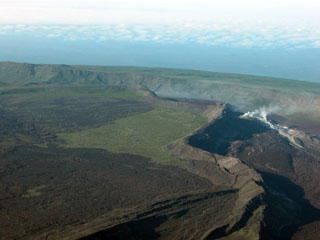Report on Sierra Negra (Ecuador) — 29 August-4 September 2018
Smithsonian Institution / US Geological Survey
Weekly Volcanic Activity Report, 29 August-4 September 2018
Managing Editor: Sally Sennert.
Please cite this report as:
Global Volcanism Program, 2018. Report on Sierra Negra (Ecuador) (Sennert, S, ed.). Weekly Volcanic Activity Report, 29 August-4 September 2018. Smithsonian Institution and US Geological Survey.
Sierra Negra
Ecuador
0.83°S, 91.17°W; summit elev. 1124 m
All times are local (unless otherwise noted)
IG reported that the eruption at Sierra Negra that began on 26 June was divided into two main phases. The first and most energetic phase lasted one day (26 June) and was characterized by the opening of five fissures and lava flows traveling as far as 7 km from the vents. Lava was only produced from fissure 4 during the 57-day-long second phase (27 June-23 August), with lava reaching the sea on 6 July and expanding the coastline. By 25 August the lava flows in total covered an area of 30.6 square kilometers. Activity continued to decline the last week of August with decreased seismicity, gas emission, and no surficial activity visible.
Geological Summary. The broad shield volcano of Sierra Negra at the southern end of Isabela Island contains a shallow 7 x 10.5 km caldera that is the largest in the Galápagos Islands. Flank vents abound, including cinder cones and spatter cones concentrated along an ENE-trending rift system and tuff cones along the coast and forming offshore islands. Although it is the largest of the five major Isabela volcanoes, it has the flattest slopes, averaging less than 5° and diminishing to 2° near the coast. A sinuous 14-km-long, N-S-trending ridge occupies the west part of the caldera floor, which lies only about 100 m below its rim. The Volcán de Azufre fumarolic area lies within a graben between this ridge and the west caldera wall. Lava flows from a major eruption in 1979 extend all the way to the north coast from circumferential fissure vents on the upper northern flank.
Source: Instituto Geofísico-Escuela Politécnica Nacional (IG-EPN)

